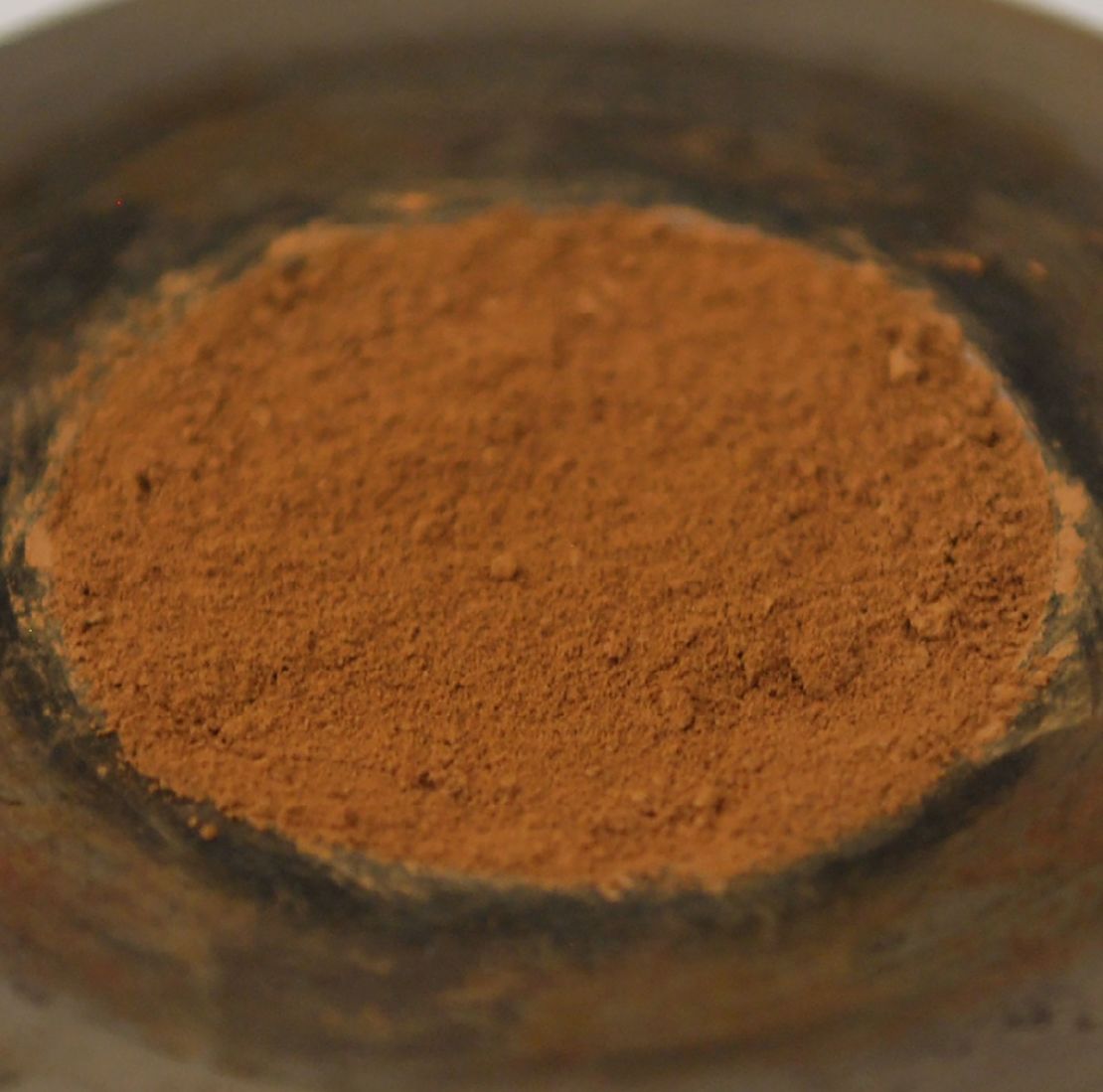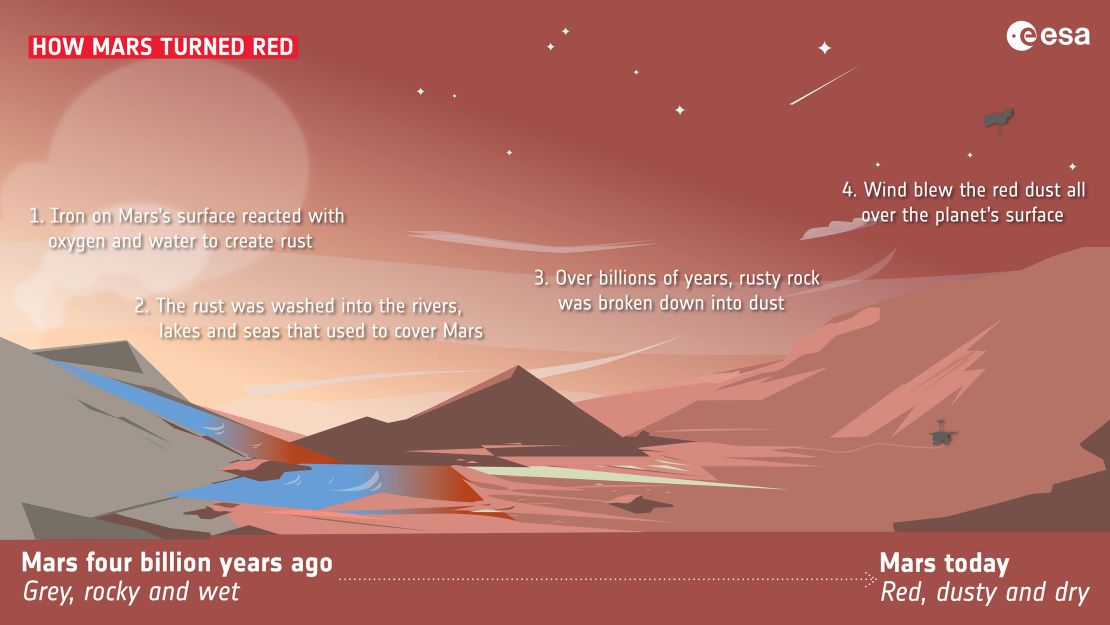Sign up for CNN’s Wonder Theory science newsletter. Explore the universe with news on fascinating discoveries, scientific advancements and more.
CNN
—
With its iconic rusty hue, Mars has long been called the red planet. Now, scientists may have discovered the potential source of that distinctive coloring, overturning a popular theory in the process.
Mars is one of the most well-studied planets in our solar system due to its proximity to Earth and the numerous spacecraft that have visited over the past few decades. Together, orbiters and landers have provided scientists with data showing that Mars’ red color comes from rusted iron minerals within the dust that coats the planet.
At some point, iron within rocks on Mars reacted with water or water and oxygen in the air, creating iron oxide — much in the same way rust forms on Earth. Over billions of years, the iron oxide broke down into dust and settled across the planet after being moved by Martian winds, which still spins up dust devils and massive dust storms.
Previous analyses of iron oxide on Mars, based only on observations by spacecraft, didn’t detect any evidence of water, which led researchers to believe that the iron oxide must be hematite. The dry mineral, a main component of iron ore, was thought to have formed through reactions with the Martian atmosphere in a process that occurred over billions of years. If that was the case, the hematite would have formed later in Mars’ history, after it was suspected of hosting lakes and rivers on its surface.
New research combining data from multiple missions and replicated Martian dust has suggested a mineral that forms in the presence of cool water may be responsible for the red hue, rather than hematite, which could change the way scientists understand what Mars was like millions of years ago — and whether it was potentially habitable. A team of scientists reported the findings Tuesday in the journal Nature Communications.
“Mars is still the Red Planet,” said lead study author Adomas Valantinas, a postdoctoral fellow in the department of Earth, environmental and planetary sciences at Brown University, in a statement. “It’s just that our understanding of why Mars is red has been transformed.”
Scientists have wondered about the exact composition of the iron oxide in Martian dust, because understanding how it formed would enable them to essentially look back in time at what the environment and climate were like on ancient Mars.
However, even though dust covers everything on Mars, it’s difficult to study and presents an enigma, said Briony Horgan, co-investigator on the Perseverance rover mission and professor of planetary science at Purdue University in West Lafayette, Indiana. Horgan was not involved in the study.
“The particles (of oxidized iron) are so small (nanometers or less) that they don’t really have a defined crystal structure and can’t be called true minerals,” Horgan said. “There are ways to form oxidized iron without water, and some proposed dry processes include surface oxidation like the oxidation rinds that form in rocks in the Antarctic Dry Valleys, and surface oxidation by abrasion as the surface is blasted with sand grains over long periods. But there are also lots of ways to oxidize with water too, including in soils and lakes.”
The new analysis points to a different type of iron oxide that contains water called ferrihydrite, which forms quickly in cool water — and likely formed on Mars when water could still exist on the surface before the planet grew colder and more inhospitable. Previous research has suggested ferrihydrite as a possible cause of Mars’ redness, but the new study has combined lab methods with observational data for the first time to offer up evidence.
“This paper is trying to figure out which specific poorly crystalline iron oxide could be responsible for the red component of Mars dust, which would be helpful to work out as that could help us determine which process produced the dust and when that occurred,” Horgan said.

Valantinas and his team made use of data collected by the European Space Agency’s Mars Express orbiter and the ExoMars Trace Gas Orbiter, as well as NASA’s Mars Reconnaissance Orbiter and the Curiosity, Pathfinder, and Opportunity rovers.
The Trace Gas Orbiter’s CaSSIS color camera, also known as the Colour and Stereo Surface Imaging System, revealed the exact size and composition of dust particles on Mars, allowing the researchers to make their own version on Earth.
The scientists created their own Martian dust in a laboratory using different types of iron oxide. The replica dust was put through a specialized grinder to create grains equal in size to those on Mars with a thickness equivalent to 1/100th of a human hair.
The team analyzed the dust with X-ray machines and reflectance spectrometers, similar to the techniques used by orbiters studying Mars as they circle the planet. Then, the scientists compared the lab data with spacecraft data.
Mars Express’ OMEGA reflectance spectrometer showed that even the dustiest parts of Mars hold evidence of water-rich minerals, while data from CaSSIS pointed to the presence of ferrihydrite as the best match for dust on Mars, rather than hematite, when compared with the lab samples, Valantinas said.
The instrument has been observing Mars since April 2018, capturing high-resolution color images of the Martian surface, said Nicolas Thomas, a professor at the Physics Institute at the University of Bern in Switzerland who led the team that developed the camera.
“We found that ferrihydrite mixed with basalt, a volcanic rock, best fits the minerals seen by spacecraft at Mars,” said Valantinas, who began his research at the University of Bern using Trace Gas Orbiter data. “The major implication is that because ferrihydrite could only have formed when water was still present on the surface, Mars rusted earlier than we previously thought. Moreover, the ferrihydrite remains stable under present-day conditions on Mars.”
The mystery of Mars’ red hue has persisted for thousands of years, Valantinas said.
Romans named Mars for their god of war because its color was reminiscent of blood and Egyptians called the planet “Her Desher,” meaning “the red one,” according to the European Space Agency.
Discovering that Mars’ hue may be due to a water-containing rusty mineral like ferrihydrite, as opposed to hematite’s waterless form of rust, surprised the researchers, Valantinas said. But it provides intriguing clues about Mars’ geologic and climate history, he said.
“Since this water-containing rust blankets most of the Martian surface, it suggests that liquid water in Mars’ ancient past may have been more widespread than previously thought,” Valantinas said. “This suggests that Mars once had an environment where liquid water was present, which is an essential prerequisite for life. Our study reveals that ferrihydrite formation on Mars required the presence of both oxygen — whether from the atmosphere or other sources — and water capable of reacting with iron.”

The study wasn’t focused on determining when exactly the mineral formed. However, since ferrihydrite forms in cool water, it’s possible that it was created about 3 billion years ago, as opposed to when the planet was warmer and wetter millions of years before.
“This was a time of intense volcanic activity on Mars that likely triggered ice-melting events and interactions between water and rock, providing conditions favorable for ferrihydrite formation,” Valantinas said. “The timing aligns with a period when Mars was transitioning from its earlier, wetter state to its current desert environment.”
It’s possible that in addition to being in the dust, ferrihydrite is also in layers of Martian rock. And the best way to tell will be to obtain actual samples of rocks and dust from the red planet. The Perseverance rover has already collected multiple samples containing both, and NASA and ESA are hoping to use a complex series of missions under the Mars Sample Return program to return them to Earth by the early 2030s.
“Once we get these precious samples into the lab, we’ll be able to measure exactly how much ferrihydrite the dust contains, and what this means for our understanding of the history of water — and the possibility for life — on Mars,” said Colin Wilson, ESA’s Trace Gas Orbiter and Mars Express project scientist, in a statement.
Meanwhile, the findings present new mysteries for Valantinas and his colleagues to solve, including the original source location of the ferrihydrite before it was distributed globally across Mars through dust storms and the exact chemical composition of Mars’ atmosphere when the ferrihydrite formed.
Understanding when and where the dust formed could help scientists gain insights into how the atmospheres of early Earth-like planets evolved, Horgan said.
“Ferrihydrite is really common in soils on Earth that have a lot of water moving through them in a short period of time, either because of snow melt or short periods of intense rainfall in warmer climates,” Horgan said. “We’ve also seen evidence for ferrihydrite in the lake sediments at (Mars’) Gale crater (which is being explored by the Curiosity rover). The best way to really solve this puzzle would be to get a sample of Mars dust into our labs back on Earth.”

